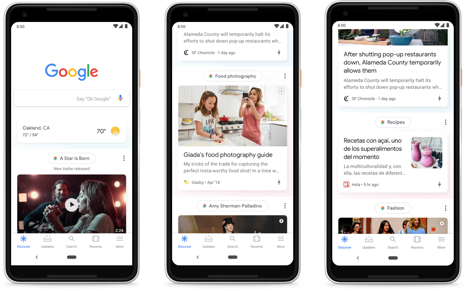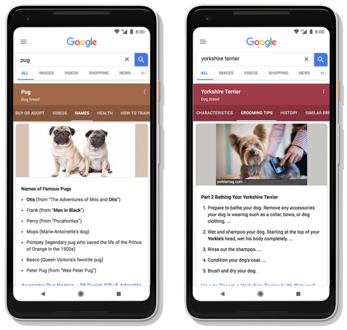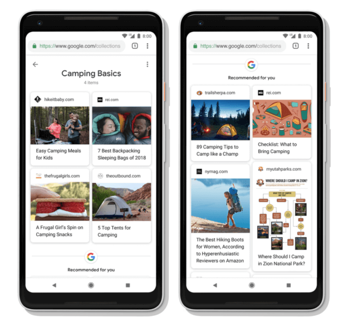Have you noticed that SEO is becoming more difficult? There’s an increasing belief that Google is a black box that none of us truly understand. The fundamentals of search optimisation are widely accepted but, as many websites successfully tick these boxes, do we truly understand what it is that pushes certain sites to perform above others?
I have a theory that we are optimising for a behaviour that is becoming less and less frequent. Search, as we understand it, is becoming less common.
The way users interact with Google is moving away from purely searching, and more into discovery, as Google pushes information to users, rather than waiting for them to pull it. If this is the case, then we need to increase our understanding of discovery, how it applies to Google, and adapt our SEO tactics to look to Discovery Engine Optimisation instead.
If you would prefer to watch me talk about this rather than read about it then you can see a video of me talking about this very subject at SearchStars 2018, here:
What is ‘Discovery’?
Discovery and search may appear to be the same thing at first glance since both involve finding new information and the answer to questions you may have. However, search is an active method whilst discovery is much more passive.
Search refers to the act of a user having a specific query (or set of queries) which they use to get single answers for each question they have. This means they typically either find their answer in the search results or click through to a domain, their search is then complete. Meanwhile, discovery involves more of a journey as it is not based on isolated queries. Instead, discovery may start with a single search, but it can also start with a prompt directly from Google (or other systems), and lead to finding more information and journeying through to related details too.
Google as a Discovery Engine
Google is traditionally known as a Search Engine, and its primary use matches the definition.

However, over the years it’s been called many other things like a personal assistant, answer engine and even just a directory. So why are we all so confused about what Google does? Google is changing frequently, updating the way users find information within it and as SEOs, we try to name these and understand them each time there is a big shift.
Here are the main reasons I believe that Google is becoming a Discovery Engine:
- Neural Matching
- The Google Feed
- The Topic Layer
- Activity Cards
- An emphasis on entities
Neural Matching
One of the first announcements for Google’s 20th anniversary was their adoption of neural matching into the algorithm. Neural Matching is currently used in around 30% of queries, which is only increasing through the use of artificial intelligence to grow its understanding. Neural Matching is Google’s way of knowing what it is that searchers really mean when they can’t find the words, it’s a step further in Google’s mission to understand the intent of searchers.
Danny Sullivan’s example of searching ‘why does my TV look strange?’ provides an interesting result which is really for the question ‘what is the soap opera effect?’ He says this happens thanks to Super Synonyms for connecting the information the user is looking for with the information which currently exists. This is breaking down a previous problem where websites produce content with jargon and exacting terminology, whilst the average consumer doesn’t know the specialist language. Neural matching is helping users to discover results and terminology they didn’t know they were looking for.
It is likely, but unproven, that neural matching will be based on the method outlined in Google’s research on Deep Relevance Ranking. Their paper outlines a new way of ranking websites based purely upon the search query and the information on the web page, different to other methods which involve looking at network structures and links between content. This may not feel like a stark contrast but it enables a more intelligent understanding of the information returned on each query.
The Google Feed
Those using the Google app on mobile will be used to seeing suggested information and stories below their search option, this is known as the Google Feed. In September 2018, the rebrand of this feature took place and became ‘Discover’ – a fairly big indication that Google is focusing on discovery. They’ve also announced that we’ll begin to see this discovery functionality on the mobile web interface too, starting in the US but soon to roll out to other countries.

As you can see from these images of Google Discover, the information is split into categories which can be browsed (much like Twitter moments) that Google believes you will be interested in. If you’re on Google to look at the latest news or your favourite brands, information about them will automatically appear here in Discover without requiring the user to even undertake a search.
The Topic Layer
If you’re following trends in how Google works you’ll be aware of the Knowledge Graph, the web of connected information that fuels Google’s answer boxes and understanding of information on the web. The Topic Layer is the next stage of developing this, sitting above the Knowledge Graph answers, by helping to build connections between each piece of ‘knowledge’ and preempting the information a user would want next.
This has added a new level of customisation to answer boxes, with the cards displayed in search results being unique to the topic displayed instead of generic by vertical. This is best seen in Google’s example of searching for dog breeds:

As you can see, the options which appear on this knowledge graph card are not the same across both breeds of dog. That’s because the topic layer here has injected the most relevant categories related to each breed, rather than just a generic ‘dog breed’ information pack. This means that users are more likely to discover the information that they will need next following their initial query – much more useful than a standard card where they may need to perform another search to get more specific information.
Activity Cards
Activity Cards are a way in which Google is acknowledging that searches do not occur in isolation, frequently they are part of a longer planning process and require a user to repeat the same search multiple times over a certain period. The new activity cards will allow users to resume previous searches they’ve done, as well as store result into collections – perfect for planning a trip or arranging an event.

Within these collections, Google may also recommend information to you and help users to discover more information around the topic they are researching without additional queries. This takes the search process away from single interactions and becomes more of a journey to undertake.
Entities
Let’s consider that entities can be domains and non-domains. A non-domain entity will be something like a TV show, celebrity or popular brand, this means that their value online is made up of more than just the domain but also includes things like their social profiles, additional authoritative sites about them, offline information and the frequency they’re searched for, alongside other factors. If we only optimise for the domain in these cases then we’re only optimising a sub-entity of a much larger piece.
To apply this to Google, the strength of the entity will be related to how well the domain (sub-entity) ranks, as well as impact elements like voice search, answer boxes and other forms of discovery. As Dave Davis said: “The idea that we can push our rankings forward through entity associations, and not just links, is incredibly powerful and versatile.”
How to Optimise for Discovery
If we move forward with the hypothesis that Google is becoming a Discovery Engine, it’s then important to adapt our tactics to work towards this type of behaviour. Moving away from a focus on Search Engine Optimisation and into Discovery Engine Optimisation. Here’s how:
- Understand How Traditional Ranking Factors are Evolving
Much of the information we’ve discussed above leads to the conclusion that we will soon need a new way of optimising. Traditionally, we’d look to factors such as external links, site architecture or keywords, but the way these are being assessed is shifting. As Google is looking more to entities and if the content really provides the best, unique answer for users, so we can begin to look more to this instead. If Google introduces its Deep Relevance Matching Model into the algorithm, be this through neural matching or another way, our work will need to be much more concentrated on understanding user intent and optimising for that instead. - Look at Entire Journeys
As discovery limits the number of progressive searches that take place and replaces them with either direct browsing or a single search followed by browser behaviour, we need to understand what the next query would have been. This means connecting the information, which Google would then want to provide to a user, by understanding common patterns and journeys which are seen. - Structure your Content for Answer Boxes
With fewer searches taking place, the prominence of answer boxes (and how they interact with the Topic Layer) has increased significantly. It’s crucial to write content in a structure which is suitable for holding these positions. - Use Structured Markup
Structured markup is widely acknowledged as being an important part of ranking and of Google understanding your content. If Google understands the content and purpose of your site, it will be able to push the information back to consumers and understand you better as an entity. - Be User Centric
Google openly talks about how they adapt to benefit users, helping them on their journey. Yet, as websites and businesses, very few of us are truly user-centric. It’s time to shift our entire approaches to put users at the centre, not just users who spend money. - Deserve to Rank
This has been the case for some time but it can’t be stressed enough, as the importance of the easier-to-manipulate factors decreases, it’s up to websites now to deserve to rank. This means giving users answers to their questions, providing unique details and being authoritative in your sector. No longer can you get away with producing quickly spun content, instead it’s about investing time in quality and detail in all content offerings.
Watch out for our upcoming posts on the changing face of search to understand some of the tactics you can implement today to prepare your site for Google’s changes.
If you’re interested in how Found could supercharge your digital performance across SEO, PPC, Social and Digital PR, then get in touch today to speak to a member of the team.


